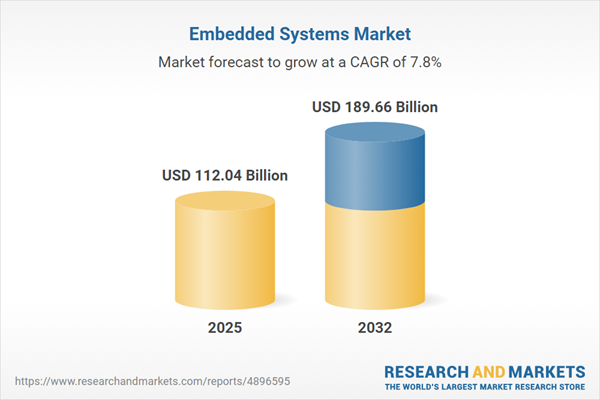Speak directly to the analyst to clarify any post sales queries you may have.
The embedded systems market is evolving quickly as technology integration, real-time analytics, and enhanced connectivity become critical for industrial and infrastructure operations. Senior leaders must rethink strategies to address new architecture demands, regulatory shifts, and increased supply chain complexity.
Market Snapshot: Embedded Systems Market Growth and Outlook
The embedded systems market grew from USD 104.33 billion in 2024 to USD 112.04 billion in 2025. It is projected to expand at a CAGR of 7.75%, reaching USD 189.66 billion by 2032. Continued digital transformation, widespread adoption of intelligent platforms, and embedding solutions in mission-critical operations drive this momentum. The adoption trajectory gains strength as organizations leverage embedded systems for advanced automotive features, manufacturing automation, future-ready urban infrastructure, and new healthcare applications. Shorter innovation cycles and heightened regulation are shaping the competitive landscape and influencing investment priorities.
Scope & Segmentation: Drivers, Segments, and Regional Dynamics
- Component: Covers I/O interfaces, digital signal processors, general purpose processors, microcontrollers, microprocessors, memory devices, power supplies, firmware, middleware, and operating systems—demonstrating the breadth of technologies delivering system reliability and performance.
- Embedded Systems Type: Includes mobile, networked, hard real-time, soft real-time, and stand-alone platforms, each tailored to unique connectivity and latency needs across sectors.
- System Size: Spans from compact embedded subsystems to complex architectures, supporting applications from consumer devices to industrial automation, aerospace, and defense.
- Application: Involves aerospace and defense, automotive uses such as driver assistance and infotainment, consumer electronics, energy and utilities, healthcare systems, industrial automation, IT, and telecommunications—enabling targeted, industry-specific innovation.
- Regions: Analyzes opportunities across the Americas, Europe, Middle East & Africa, and Asia-Pacific, with detailed insight on major countries including China, India, Japan, South Korea, and Southeast Asia.
- Key Players: Examines strategies from Advantech, Analog Devices, Arm, Broadcom, Cisco, Honeywell, Infineon, Intel, Kontron, Microchip, Mitsubishi Electric, NVIDIA, NXP, Panasonic, Qualcomm, Real-Time Systems, Renesas, Samsung, Siemens, STMicroelectronics, Texas Instruments, Wind River Systems, and WIPRO, helping stakeholders benchmark industry leadership and innovation.
Key Takeaways for Market Leaders
- Edge computing and artificial intelligence are being implemented at the device level, empowering embedded intelligence that improves operational outcomes.
- Shifts in regulations and regional production are redefining global supply chains while boosting automation strategies.
- Processor and power management advancements are promoting energy-efficient hardware, with middleware simplifying integration across platforms.
- Reliability and safety are strengthened through ongoing innovation, particularly in sectors governed by strict operational or compliance requirements.
- Cross-disciplinary efforts among hardware, software, and integration experts are enabling targeted embedded solutions for specific industry challenges.
- Strategic mergers and acquisitions are consolidating expertise, leading to solutions that support efficient deployment and lifecycle management within enterprises.
Tariff Impact: Navigating U.S. 2025 Tariffs and Global Supply Disruptions
The introduction of United States tariffs in 2025 is encouraging companies to review sourcing strategies for embedded systems, pushing for diversification and localized production of critical components. OEMs are forming new regional partnerships and automating workflows to increase the value and efficiency of existing hardware assets. These dynamics highlight the need for flexible strategies and a robust supplier network, underscoring the importance of supplier resilience when offsetting upstream risks.
Methodology & Data Sources
Research combines interviews with senior executives, system architects, and procurement decision-makers from leading embedded systems firms. Insights are validated through comprehensive secondary sources, including industry reports, regulatory filings, and patent analysis. Conclusions offer reliable, executive-level planning support.
Why This Report Matters for Decision-Makers
- Helps leadership teams anticipate regulatory changes and new technologies, allowing proactive adjustments to corporate strategy.
- Guides resource investment into partnerships, research, and workforce development to accelerate organizational growth in the embedded systems space.
- Enables clear, actionable communication with stakeholders, turning technical developments into strategic guidance for better executive decisions.
Conclusion
Building distributed intelligence and resilient supply chains positions organizations to benefit from the embedded systems of tomorrow. Decisions made now secure long-term competitive position as digital and regulatory demands progress.
Additional Product Information:
- Purchase of this report includes 1 year online access with quarterly updates.
- This report can be updated on request. Please contact our Customer Experience team using the Ask a Question widget on our website.
Table of Contents
3. Executive Summary
4. Market Overview
7. Cumulative Impact of Artificial Intelligence 2025
List of Figures
Samples

LOADING...
Companies Mentioned
The key companies profiled in this Embedded Systems market report include:- Advantech Co., Ltd.
- Analog Devices, Inc.
- Arm Limited
- Broadcom Inc.
- Cisco Systems, Inc
- Honeywell International Inc.
- Infineon Technologies AG
- Intel Corporation
- Kontron AG
- Microchip Technology Incorporated
- Mitsubishi Electric Corporation
- NVIDIA Corporation
- NXP Semiconductors N.V.
- Panasonic Holdings Corporation
- Qualcomm Incorporated
- Real-Time Systems GmbH
- Renesas Electronics Corporation
- Samsung Electronics Co., Ltd.
- Siemens Aktiengesellschaft
- STMicroelectronics N.V.
- Texas Instruments Incorporated
- Wind River Systems, Inc.
- WIPRO LIMITED
Table Information
| Report Attribute | Details |
|---|---|
| No. of Pages | 182 |
| Published | October 2025 |
| Forecast Period | 2025 - 2032 |
| Estimated Market Value ( USD | $ 112.04 Billion |
| Forecasted Market Value ( USD | $ 189.66 Billion |
| Compound Annual Growth Rate | 7.7% |
| Regions Covered | Global |
| No. of Companies Mentioned | 24 |









